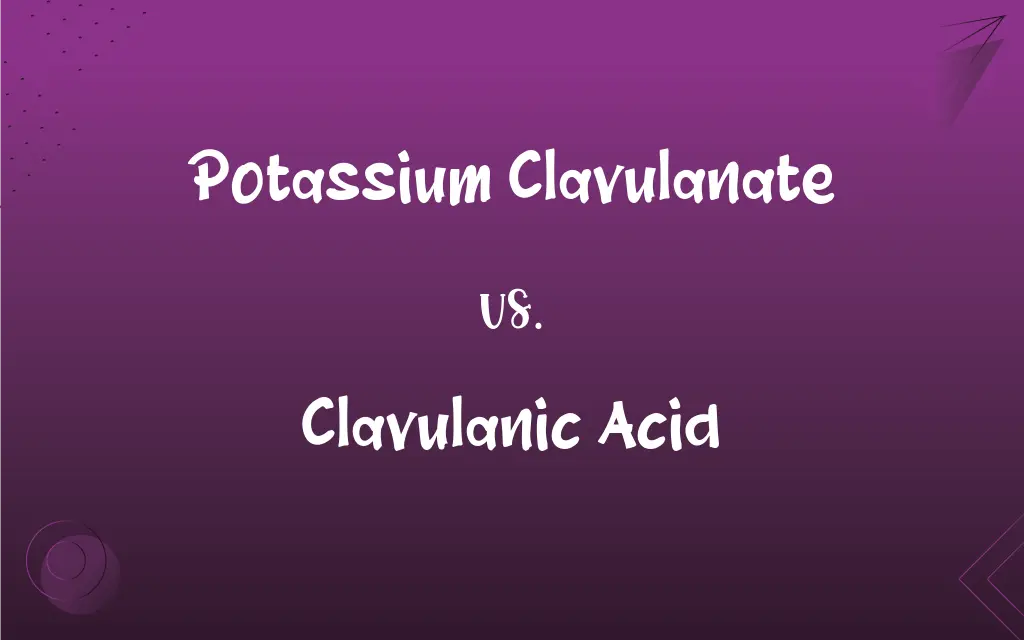Potassium Clavulanate vs. Clavulanic Acid: What's the Difference?
Edited by Harlon Moss || By Janet White || Published on January 31, 2024
Potassium clavulanate is a potassium salt form of clavulanic acid, used to inhibit bacterial enzyme action. Clavulanic acid is a beta-lactamase inhibitor enhancing antibiotic effectiveness.

Key Differences
Potassium clavulanate is the potassium salt derivative of clavulanic acid. It is formulated for medical use where potassium ions play a role in its stability and solubility. Clavulanic acid, on the other hand, is a naturally occurring beta-lactamase inhibitor, initially isolated from Streptomyces clavuligerus. Its structure closely resembles that of penicillin.
Potassium clavulanate is primarily used in combination with antibiotics like amoxicillin to enhance their effectiveness against certain bacteria. This combination overcomes the issue of antibiotic resistance due to beta-lactamase enzymes produced by some bacteria. Clavulanic acid itself, while not an antibiotic, plays a crucial role in inhibiting these beta-lactamase enzymes, thereby protecting the antibiotic from degradation.
When formulated as potassium clavulanate, it facilitates better absorption in the human body compared to clavulanic acid alone. This is crucial in ensuring the inhibitor reaches adequate plasma concentrations to be effective. Clavulanic acid, being the active component, provides the necessary beta-lactamase inhibition, but its pharmacokinetics are enhanced when bonded with potassium.
The side effects associated with potassium clavulanate are similar to those of clavulanic acid, as the active component is the same. However, the presence of potassium might influence its interaction with other medications or conditions related to potassium levels in the body. Clavulanic acid's side effects are often related to its combination with other antibiotics.
In pharmaceutical manufacturing, potassium clavulanate is synthesized to create a stable, effective form suitable for combination with various antibiotics. Clavulanic acid, though the active ingredient, is not typically used alone due to its instability and poor pharmacokinetic profile compared to its potassium salt form.
ADVERTISEMENT
Comparison Chart
Chemical Form
Potassium salt of clavulanic acid
Beta-lactamase inhibitor, naturally occurring
Primary Use
Combined with antibiotics for enhanced effectiveness
Inhibitor of beta-lactamase enzymes
Pharmacokinetics
Enhanced absorption due to potassium
Less effective alone in pharmacokinetics
Side Effects
Similar to clavulanic acid, with added considerations for potassium
Related to beta-lactamase inhibition
Manufacturing
Synthesized for stability and efficacy in combination therapies
Not commonly used alone in pharmaceuticals
ADVERTISEMENT
Potassium Clavulanate and Clavulanic Acid Definitions
Potassium Clavulanate
Potassium Salt Form.
Its formulation ensures better drug absorption and effectiveness.
Clavulanic Acid
Pharmacological Enhancer.
When paired with antibiotics, it significantly improves their efficacy.
Potassium Clavulanate
Antibiotic Enhancer.
Potassium clavulanate, when combined with amoxicillin, effectively treats resistant bacterial infections.
Clavulanic Acid
Enzyme Inhibitor.
It effectively neutralizes the bacteria's defense against antibiotics.
Potassium Clavulanate
Medical Ally.
Essential in treating infections caused by beta-lactamase producing bacteria.
Clavulanic Acid
Natural Origin.
Initially derived from Streptomyces clavuligerus, it's a breakthrough in antibiotic therapy.
Potassium Clavulanate
Beta-lactamase Inhibitor.
This compound inhibits enzymes that bacteria use to resist certain antibiotics.
Clavulanic Acid
Antibiotic Resistance Combatant.
It's a critical tool in the fight against antibiotic-resistant infections.
Potassium Clavulanate
Resistance Overcomer.
It's used to overcome bacterial resistance in penicillin-like antibiotics.
Clavulanic Acid
Beta-lactam Structure.
Clavulanic acid, resembling penicillin, inhibits key bacterial enzymes.
FAQs
Is clavulanic acid an antibiotic?
No, it's an enzyme inhibitor, not an antibiotic.
What is clavulanic acid?
A naturally occurring beta-lactamase inhibitor.
How does potassium clavulanate work?
It inhibits bacterial enzymes that degrade antibiotics.
Are there side effects to potassium clavulanate?
Yes, similar to clavulanic acid, but with additional considerations for potassium.
Why is potassium added to clavulanic acid?
To improve its stability and absorption in the body.
What is potassium clavulanate?
A potassium salt form of clavulanic acid, used to enhance antibiotic effectiveness.
Is potassium clavulanate safe for everyone?
Generally yes, but not for those with potassium-related health issues.
Does potassium clavulanate affect antibiotic resistance?
Yes, it combats antibiotic resistance.
What types of infections does clavulanic acid treat?
It treats infections caused by beta-lactamase producing bacteria.
Can potassium clavulanate treat viral infections?
No, it's only effective against bacterial infections.
Can clavulanic acid cause allergies?
Yes, especially in those allergic to penicillin.
Is potassium clavulanate effective against all bacteria?
It's effective against bacteria that produce beta-lactamase.
Can clavulanic acid be used alone?
It's not effective alone; it's always combined with antibiotics.
How is clavulanic acid sourced?
Originally from Streptomyces clavuligerus.
Is clavulanic acid used in all antibiotics?
No, only in specific combinations where resistance is an issue.
How does potassium clavulanate interact with other drugs?
It can interact, especially with medications affecting potassium levels.
How is clavulanic acid administered?
Orally or intravenously, always in combination with an antibiotic.
Why is clavulanic acid important in medicine?
It extends the effectiveness of antibiotics against resistant bacteria.
What is the role of clavulanic acid in combination therapies?
It inhibits the enzymes that degrade the companion antibiotic.
What antibiotics are paired with clavulanic acid?
Commonly amoxicillin and others in the penicillin group.
About Author
Written by
Janet WhiteJanet White has been an esteemed writer and blogger for Difference Wiki. Holding a Master's degree in Science and Medical Journalism from the prestigious Boston University, she has consistently demonstrated her expertise and passion for her field. When she's not immersed in her work, Janet relishes her time exercising, delving into a good book, and cherishing moments with friends and family.
Edited by
Harlon MossHarlon is a seasoned quality moderator and accomplished content writer for Difference Wiki. An alumnus of the prestigious University of California, he earned his degree in Computer Science. Leveraging his academic background, Harlon brings a meticulous and informed perspective to his work, ensuring content accuracy and excellence.































































